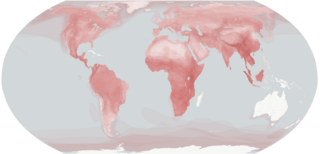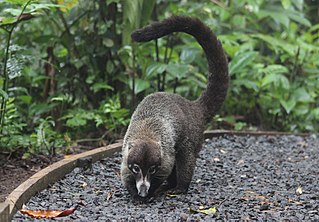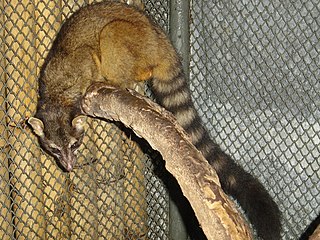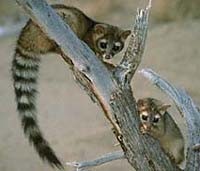
Carnivora is an order of placental mammals that have specialized in primarily eating flesh, whose members are formally referred to as carnivorans. The order Carnivora is the fifth largest order of mammals, comprising at least 279 species.

Coatis, also known as coatimundis, are members of the family Procyonidae in the genera Nasua and Nasuella. They are diurnal mammals native to South America, Central America, Mexico, and the southwestern United States. The name "coatimundi" comes from the Tupian languages of Brazil, where it means "lone coati". Locally in Belize, the coati is known as "quash".

The ringtail is a mammal of the raccoon family native to arid regions of North America. It is widely distributed and well adapted to disturbed areas. It has been legally trapped for its fur. It is listed as Least Concern on the IUCN Red List. The species is known by variety of different names, such as ring-tailed cat, miner's cat,civet cat, and cacomistle, though the last of these can refer to B. sumichrasti.

Procyonidae is a New World family of the order Carnivora. It comprises the raccoons, ringtails, cacomistles, coatis, kinkajous, olingos, and olinguitos. Procyonids inhabit a wide range of environments and are generally omnivorous.

Procyon is a genus of nocturnal mammals comprising three species commonly known as raccoons in the family Procyonidae. The most familiar species, the common raccoon, is often known simply as "the" raccoon, as the two other raccoon species in the genus are native only to the tropics and less well known. Genetic studies have shown that the closest relatives of raccoons are the ring-tailed cats and cacomistles of genus Bassariscus, from which they diverged about 10 million years ago.

The kinkajou is a tropical rainforest mammal of the family Procyonidae related to olingos, coatis, raccoons, and the ringtail and cacomistle. It is the only member of the genus Potos and is also known as the "honey bear". Kinkajous are arboreal, a lifestyle they evolved independently; they are not closely related to any other tree-dwelling mammal group.

The pottos are three species of strepsirrhine primate in the genus Perodicticus of the family Lorisidae. In some English-speaking parts of Africa, they are called "softly-softlys".

The cacomistle, also spelled cacomixtle, is a nocturnal, arboreal and omnivorous member of the carnivoran family Procyonidae. Its preferred habitats are wet, tropical, evergreen woodlands and mountain forests, though seasonally it will venture into drier deciduous forests.

Nasua is a genus of coatis of the family Procyonidae. Two additional species of coatis, commonly known as mountain coatis, are placed in the genus Nasuella.

Mountain coatis are two species of procyonid mammals from the genus Nasuella. Unlike the larger coatis from the genus Nasua, mountain coatis only weigh 1.0–1.5 kilograms (2.2–3.3 lb) and are endemic to the north Andean highlands in South America.

Caniformia is a suborder within the order Carnivora consisting of "dog-like" carnivorans. They include dogs, bears, raccoons, and mustelids. The Pinnipedia are also assigned to this group. The center of diversification for the Caniformia is North America and northern Eurasia. Caniformia stands in contrast to the other suborder of Carnivora, the Feliformia, the center of diversification of which was in Africa and southern Asia.

The genus Bassaricyon consists of small Neotropical procyonids, popularly known as olingos, cousins of the raccoon. They are native to the rainforests of Central and South America from Nicaragua to Peru. They are arboreal and nocturnal, and live at elevations from sea level to 2,750 m. Olingos closely resemble another procyonid, the kinkajou, in morphology and habits, though they lack prehensile tails and extrudable tongues, have more extended muzzles, and possess anal scent glands. However, the two genera are not sisters. They also resemble galagos and certain lemurs.

Leopardus is a genus comprising eight species of small cats native to the Americas. This genus is considered the oldest branch of a genetic lineage of small cats in the Americas whose common ancestor crossed the Bering land bridge from Asia to North America in the late Miocene.

The western mountain coati or western dwarf coati is a small procyonid, found in cloud forest and páramo at altitudes of 1,300–4,250 metres (4,270–13,940 ft) in the Andes of Colombia and Ecuador. A population discovered in the Apurímac–Cuzco region of southern Peru has tentatively been identified as the western mountain coati, but may represent an undescribed taxon.

The South American coati, also known as the ring-tailed coati, is a coati species and a member of the raccoon family (Procyonidae), found in the tropical and subtropical parts of South America. An adult generally weighs from 2–7.2 kg (4.4–15.9 lb) and is 85–113 cm (33–44 in) long, with half of that being its tail. Its color is highly variable and the rings on the tail may be only somewhat visible, but its most distinguishing characteristic is that it lacks the largely white snout of its northern relative, the white-nosed coati.

The Cozumel raccoon is a critically endangered species of island raccoon endemic on Cozumel Island off the coast of the Yucatan Peninsula, Mexico. It is also called the pygmy raccoon, dwarf raccoon, Cozumel Island raccoon, and Cozumel raccoon bear.
Ringtail, ring tail, or ring-tail may refer to:

The eastern mountain coati or eastern dwarf coati is a small procyonid found in cloud forest and páramo at elevations of 2,000–4,000 m (6,600–13,100 ft) in the Andes of western Venezuela. Until 2009, it was included as a subspecies of the western mountain coati, but the eastern mountain coati is overall smaller, somewhat shorter-tailed on average, has markedly smaller teeth, a paler olive-brown pelage, and usually a dark mid-dorsal stripe on the back versus more rufescent or blackish, and usually without a dark mid-dorsal stripe in the western mountain coati. When the two were combined, they were classified as Data Deficient on the IUCN Red List but following the split the eastern mountain coati is considered endangered. A genetic analysis revealed that it should be regarded as a synonym of N. olivacea.

The olinguito is a mammal of the raccoon family Procyonidae that lives in montane forests in the Andes of western Colombia and Ecuador. It was classified as belonging to a new species in 2013. The specific name neblina is Spanish for fog or mist, referring to the cloud forest habitat of the olinguito.



















